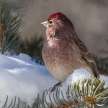
A poorly known Tumbesian tinamou, this species is endemic to a comparatively small region of western Ecuador, named for its distinctive pale ear, and is even more widespread in northwest Peru. Pale-browed Tinamou is officially classified as Near Endangered, as its population is accused of a relatively swift and gradual decline. Pale-brown Tinamou, however, remains relatively common in suitable habitat, from the lowlands up to 1500 m of tropical dry forest. This tinamou appears to have quite the high tolerance to a degree of habitat destruction while it prefers denser vegetated areas. Both sexes are generally grayer below, with a white throat, and browner over the wings and upper parts, but over the back and ear coverings, females are more heavily barred than males are. The song is an uplifting explosive wheeep. The nesting season lasts from November to February, in Ecuador at least, and Pale-browed Tinamou lay up to seven eggs at a time. Even, little much appears to be understood about the developmental past of this genus. Tinamous are stocky, with very short tails and long wings, so overall they are quite the little creatures. Pale-browed Tinamou is a medium sized tinamou with distinctive plumage style. The broad, pale supercilium is a prominent attribute in both genders that gives this species its English name. The male above is greyish to reddish brown, with lower back and some barring in the body. The breast is brunette, more or less. The female looks much like the male except that the upper parts of black and buff and ochre blue are more heavily barred. The Tarsi and the ores are reddish in both sexes. Pale-brewed Tinamou has a very limited geographical distribution, within which it overlaps with only a few other tinamou populations. Locally Light-brown Tinamou overlaps with Little Tinamou, but Little Tinamou prefers more tropical woodland, is smaller, and has a more uniform pattern, with little to no barrier and lacks the prominent violet "beard." Small Tinamou has yellowish or olive colours as well, not purple, tarsi and toes. Andean Tinamou has yellow tarsi and toes, a bent bill and the upper parts especially streaked. Both tinamou are from the Tinamidae tribe, and therefore are ratites in the greater scheme. Unlike other ratites, tinamous can float, but they aren't good fliers in general. Both ratites originated from ancient flying birds and tinamous are the nearest living relative to these birds. The tinamou, light grey, is about 28 cm tall. It is recognised by its upper greyish-brown coat, finely vermiculated with black, and a white throat, with the majority of its subparts greyish to buffy. It's got barred flanks and a very dark crown, with a bright white supercilium. The pale-brown tinamou eats fruit from the ground or low-lying plants, and less invertebrates, flower buds, delicate leaves, seeds and roots. The male incubates the eggs from as many as five different females, and then raises them up so they can be free. The nest is on the ground in dense scrub, between elevated root buttresses. Pale-browned Tinamou's song is described as "a loud, resonant whooit, usually given at intervals longer than 30 seconds;" as "a fast, heavy, ringinging ooo-eee? or ooo-ing with liquid quality;" and as "an extreme, penetrating, rising cuuEEE?" On the farm pale-brewed Tinamou forages. This can be noticed during the dry season by the rustling sound that they create while walking over dried leaf litter. Pale-brown Tinamou is fairly common, and tends to tolerate some habitat loss. Nonetheless, it has a limited geographical range, and the population is believed to be declining due to habitat loss and degradation and poaching
About the Creator
MB
I am a bird aficionado and really enjoy spotting them them on hikes. I greatly appreciate the variety of birds cross North America and the world. They are amazing and intelligent creatures, each so unique and with a wonderful life.






Comments
There are no comments for this story
Be the first to respond and start the conversation.